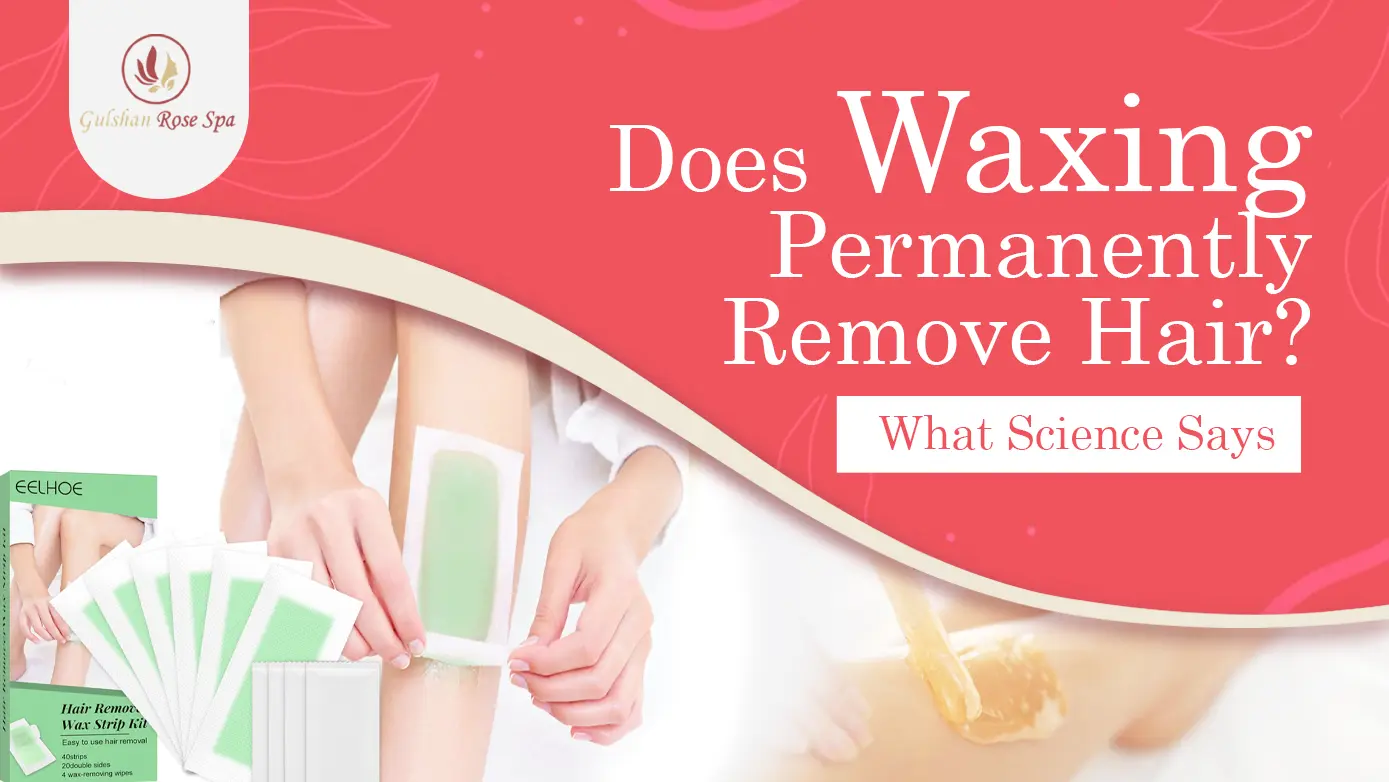Having regularly waxed your hair and wondering if it will eventually stop growing altogether, you’re not alone. Many people ask, “Does waxing permanently remove hair?” or search for answers like, “How long do I have to wax for my hair to stop growing?”
The truth is that waxing reduces hair density over time, but it does not permanently remove hair.

In this blog, we’ll talk about how waxing affects your hair growth cycle, how sugar waxing differs from traditional waxing, and which methods are best for permanent hair removal. Whether you’re considering sugar waxing or traditional waxing, this guide offers trustworthy information based on real facts.
What Is Waxing and How Does It Work?
Waxing is a hair removal method that involves applying warm wax to the skin and removing it quickly, pulling hair out from the root (follicle level). By contrast to shaving, which cuts the hair at the surface, waxing removes the entire hair shaft, leading to:
- Slower regrowth
- Finer texture
- Less frequent maintenance
It can be performed using hard wax, soft wax, or sugar wax, and it can be done on many body parts, including the arms, legs, back, chest, and even the face.
Does Waxing Permanently Remove Hair?
Although waxing is often regarded as a long-lasting hair removal method, it won’t permanently get rid of hair. Despite the visible reduction in hair growth over time, this is a common misconception.
The science behind waxing shows that while it removes hair from the root level (follicle bulb), it does not destroy it. It means that the follicle remains active and is capable of producing new hair in subsequent growth cycles.
What Waxing Can Do Over Time:
- Delay Regrowth: Since the entire shaft of the hair is removed, new hair takes longer to grow than if it were shaved.
- Refine Hair Texture: Regrowing hair becomes finer, lighter, and softer with repeated waxing, especially with long-term use.
- Visibly Reduce Density: Hair follicles may become less active, resulting in sparser patches and reduced growth.
What Waxing Cannot Do:
- Permanently Disable Hair Follicles: Waxing does not deliver the thermal or chemical damage required to deactivate a follicle permanently.
- Completely Stop Regrowth: Because hair grows in cycles and from numerous follicles, regrowth is inevitable, even with consistent waxing.
Due to this, waxing is considered a semi-permanent hair removal method. As long as consistency is maintained, it can deliver long-lasting smoothness, but it will not eliminate hair growth for good.
Key Factors That Influence Hair Reduction Over Time

In spite of the fact that waxing consistently reduces visible hair over time, the degree of reduction varies from person to person. The effectiveness of waxing is influenced by several biological, hormonal, and treatment-related factors.
1. Hormonal Profile
It is well known that testosterone and DHT influence body hair growth, especially in men. A high androgen level or hormonal disorder such as PCOS can cause faster and denser regrowth, regardless of regular waxing.
2. Genetics
Your genetics determines how many hair follicles you have, their growth rate, and their texture. The regrowth of hair can be slower for some individuals, while it can be dense for others, even after waxing.
3. Age
The activity of hair follicles naturally declines as people age. In older people, waxing may result in slower regrowth and longer-lasting results, since hair production slows down with time.
4. Waxing Frequency and Consistency
The follicle is weakened more effectively when waxing is performed at the same time that hair is in its anagen phase. When waxing is skipped or irregular, follicles have time to recover, so there is less chance of long-term hair reduction.
5. Area of the Body
Growth of hair varies between body zones. A waxing treatment often responds faster to underarms and bikini lines, but may take longer to achieve consistency on your back and legs because they have deeper follicles.
6. Skin and Hair Type
Hair that is coarse, dark, and dense responds best to waxing because it has a stronger root structure. In contrast, fine, light, or vellus hair is less reactive and may not show dramatic reductions even after repeated waxing.
Does Sugar Waxing Permanently Remove Hair?
A common question is, can sugar waxing permanently remove hair?
In the same way that traditional waxing removes hair from the root, sugar waxing does not remove hair from the follicle itself. Eventually, the hair will grow back as the natural hair cycle continues.
As long as sugar waxing is regularly performed, it offers several beneficial outcomes:
Gradual Reduction in Hair Density
When root-level extraction is repeated, some follicles may become weaker, resulting in thinner and less noticeable hair growth over time.
Minimize Irritation
With ingredients like sugar, lemon, and water, sugaring often works better for sensitive and reactive skin types.
Improve Skin Smoothness
As the paste adheres only to the hair, not the live skin cells, the skin can feel softer and more polished after the treatment.
If you’re looking for a natural, low-irritation option for smoother skin, sugaring is an excellent choice-but beware of expectations regarding permanence.
What Are the Real Permanent Hair Removal Alternatives?
Although waxing leaves skin smooth and hair regrowth thinner over time, it is not a permanent solution. If you’re looking for long-term or truly permanent results, modern dermatology treatments can provide far greater results by targeting the hair follicle at its source.
Below are three clinically recognized alternatives that go beyond temporary hair removal—each with its advantages, limitations, and suitability based on skin tone, hair color, and treatment goals.
1. Laser Hair Removal

A laser hair removal treatment uses concentrated light to target melanin in the hair shaft, damaging and heating the follicle beneath. People with dark hair and light skin are ideal candidates for this process, since the contrast in pigment improves precision.
To achieve optimal results, multiple sessions are needed, especially in areas of dense growth.
2. Electrolysis
Electrolysis is the only FDA-approved method for permanent hair removal, making it the most reliable method for complete follicular elimination. Through the insertion of a fine probe into each follicle, electrical current destroys the follicle’s growth center.
As opposed to lasers, it works with all skin tones and hair types, including fine, light, or gray hairs.
3. Intense Pulsed Light (IPL)
The Intense Pulsed Light (IPL) uses broad-spectrum light to damage hair follicles and slowly reduce regrowth. In spite of its less targeted nature, this procedure can be effective for those with a moderate contrast between the pigment of their hair and their skin.
The treatment usually involves a series of sessions, and the results may vary more widely than with lasers because of the scattered wavelengths.
Waxing Service for Men in Gulshan

For men in Dhaka, especially those living in Gulshan, waxing has become a step toward better hygiene, comfort, and skin confidence. As more men seek professional waxing services tailored to their unique needs, we’ve seen this shift firsthand at Gulshan Rose Spa.
While shaving leaves behind rough stubble, itching, and rapid regrowth, waxing eliminates hair from the root, giving you weeks of smoothness and reducing upkeep.
But what truly sets our service apart is how we approach male waxing. At Gulshan Rose Spa:
- The wax we use is specially formulated to calm male skin, which is coarser and more sensitive.
- Our trained aestheticians work discreetly and efficiently, ensuring a comfortable experience, even for first-time clients.
- Waxing helps highlight muscle tone and definition, making it popular among fitness enthusiasts and professionals alike.
- With regular waxing, hair regrows finer and slower, allowing men to maintain a clean look without daily maintenance.
Final Thoughts
When it comes to hair removal, waxing strikes a balance between convenience and results. While it may not permanently eliminate hair, it can significantly improve skin smoothness and reduce regrowth with consistent use.
To clarify, does waxing permanently remove hair? The answer is “No.” Waxing remains a trusted, semi-permanent method of smoothing skin that does not require daily maintenance. Whether you simply want to feel more confident in your skin, waxing can be a game-changer.
And if you’re located in or near Gulshan, there’s no need to search far. At the Gulshan Rose Spa, expert male waxing services are available in a serene, hygienic, and judgment-free environment, backed by a growing client base of satisfied male clients.
Frequently Asked Questions
Does waxing permanently remove hair over time?
No—waxing does not permanently eliminate hair growth, even over time. However, it can produce the appearance of long-term hair reduction, depending on a variety of personal and biological factors.
Why does hair always grow back after waxing?
The growth cycle of hair includes three phases: Anagen, Catagen, and Telogen, and waxing affects only hair in the active (anagen) stage. Since not all hairs are in the same phase at once, some hair will always return after waxing. The dormant follicles can reactivate and produce new hair when the cycle restarts. That’s why even after a year of regular waxing, regrowth never ceases entirely.
How long do I have to wax before hair stops growing?
The process is not guaranteed on a timeline. If you keep waxing consistently for 6 to 12 months, you may start to notice thinning hair, but it will continue to grow, just less frequently and sparsely.





